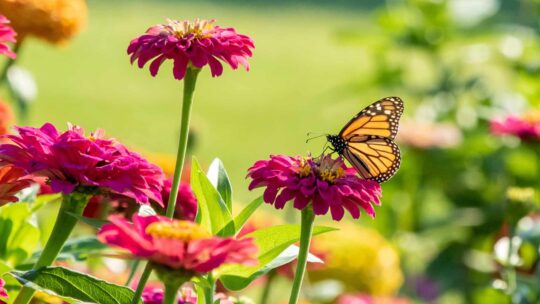Exmark ambassador and environmental scientist Grae Buck is back again with some incredible information about planning a rain garden! He’s filling you in on everything you need to know about rain gardens, what to plant, and how to care for them.
Read on to learn more!
What Is a Rain Garden?
Rain gardens serve as both an environmental and an aesthetic benefit to your backyard. While managing runoff and stormwater, rain gardens support native plant species, providing habitat for beneficial wildlife.
By definition, rain gardens are depressed areas in the landscape, planted with native vegetation, which collect rainfall and deliver it into the ground. Rain gardens help to filter pollutants through the soil, such as road salts, oils, and nutrients, and allow stormwater runoff to soak into the ground, or “infiltrate.” This helps to manage flooding, prevent erosion, and reduce pollution through stormwater runoff. Rain gardens drain within a few days, preventing mosquito development. The specialized soils in a rain garden, and the design of the garden, facilitate the delivery of water. However, water is also taken in by vegetation in the rain garden. And evapotranspiration, the process of moving water from the earth into the atmosphere, also contributes.

What Should You Plant in Your Rain Garden?
Native plants play an important role in rain gardens. Native species are adapted to local weather conditions and soils, are more pest resistant, do not typically require fertilization, and support a host of beneficial pollinators and wildlife. Once established, their deep root systems will help to stabilize soil to prevent erosion. Avoid planting any non-native, invasive, or noxious plants in your garden, which could outcompete the beneficial native species, and provide less benefit to beneficial insects and animals. When selecting plant species, consult a local native plant nursery to determine rain garden-suitable plants that will tolerate both the hydrology of a rain garden, and the other growing conditions such as soil, sunlight, and space limitations. Consider native shrubs, grasses, and perennials. Differing sizes and heights will enhance aesthetic quality. Adding plants with ‘winter interest’ such as red twig dogwood will provide color year-round. Consider berry-producing shrubs, to add food for wildlife, such as Elderberry, Black Chokeberry, or Winterberry Holly.
A few examples of great native rain garden plants for pollinators such as bees and butterflies include Butterfly Weed, Buttonbush, Arrowhead Viburnum, Wild Blue Indigo, Marsh Marigold, New England Aster, and Purple Milkweed. Choosing plants with varying flowing and fruiting seasons will provide benefits to wildlife and pollinators year-round.
Consider the Moisture Zones When Planning a Rain Garden
Consider three moisture zones when designing the planting plan for your rain garden. Shaped like a bowl, the center of a rain garden, the deepest area, will be the wettest after a rain event, holding water for 1-2 days. Plant your most water-tolerant plant species in this zone. The sides of the rain garden are a transitional zone, seeing both wet and dry conditions. Plants that can handle extreme variations in moisture will do best in this area. The upland edge areas of your rain garden will receive the least moisture, more on par with your typical garden. Plant your traditional garden plants which can handle dry conditions in this zone.
In addition to planning your zones by moisture tolerance, consider plant appearances such as color, size, and height. In the outermost zone, consider planting your shortest species by height on the outside, and tallest in the middle, for best aesthetic potential. Limit trees in rain gardens, as they uptake significantly more moisture than other plants, and their root systems could compromise the structural integrity of the garden once mature. Small water-loving trees may be appropriate, depending on the size and location of your rain garden.
Care and Keeping of Your Rain Garden
Water the garden for the first year or so following planting, to ensure establishment and survivorship of your new garden plants. Weed and inspect for invasive species, hand treating when possible. Mulch your rain garden to help retain moisture, suppress weed growth, and protect the soil surface from compaction which could limit infiltration.
Below are a few resources for plant selection. Consider all the factors discussed above, as well as the plant hardiness zone when you start planning a rain garden. Visit this site to determine your zone, if unsure. https://planthardiness.ars.usda.gov/
Resources for Plant Selection:
- Rain Garden Alliance: http://raingardenalliance.org/planting/plantlist
- Audubon Native Plants Database: https://www.audubon.org/native-plants
- Rain Gardens – The Plants: https://extension.psu.edu/rain-gardens-the-plants
More Like This:



